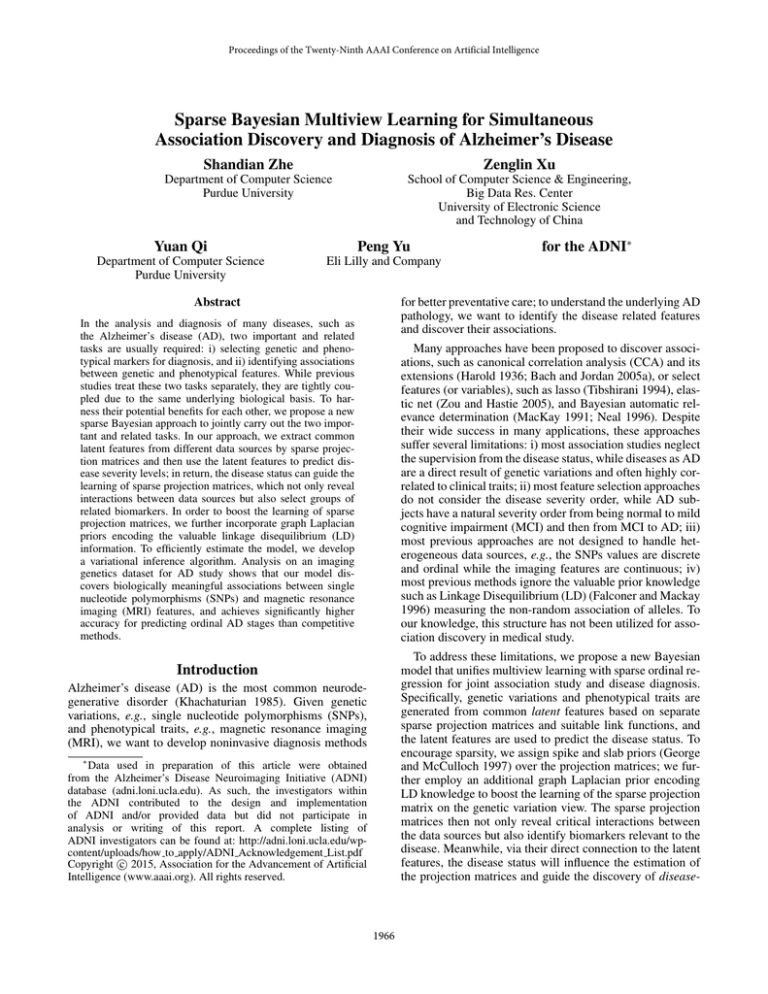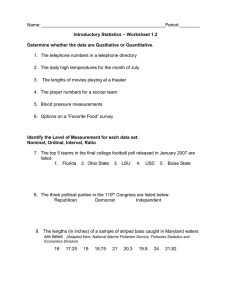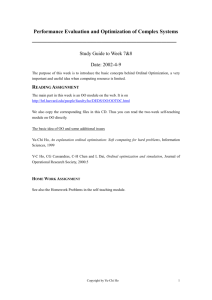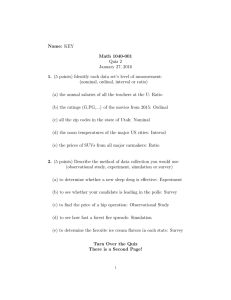
Proceedings of the Twenty-Ninth AAAI Conference on Artificial Intelligence
Sparse Bayesian Multiview Learning for Simultaneous
Association Discovery and Diagnosis of Alzheimer’s Disease
Shandian Zhe
Zenglin Xu
Department of Computer Science
Purdue University
School of Computer Science & Engineering,
Big Data Res. Center
University of Electronic Science
and Technology of China
Yuan Qi
Peng Yu
Department of Computer Science
Purdue University
Eli Lilly and Company
Abstract
for the ADNI∗
for better preventative care; to understand the underlying AD
pathology, we want to identify the disease related features
and discover their associations.
In the analysis and diagnosis of many diseases, such as
the Alzheimer’s disease (AD), two important and related
tasks are usually required: i) selecting genetic and phenotypical markers for diagnosis, and ii) identifying associations
between genetic and phenotypical features. While previous
studies treat these two tasks separately, they are tightly coupled due to the same underlying biological basis. To harness their potential benefits for each other, we propose a new
sparse Bayesian approach to jointly carry out the two important and related tasks. In our approach, we extract common
latent features from different data sources by sparse projection matrices and then use the latent features to predict disease severity levels; in return, the disease status can guide the
learning of sparse projection matrices, which not only reveal
interactions between data sources but also select groups of
related biomarkers. In order to boost the learning of sparse
projection matrices, we further incorporate graph Laplacian
priors encoding the valuable linkage disequilibrium (LD)
information. To efficiently estimate the model, we develop
a variational inference algorithm. Analysis on an imaging
genetics dataset for AD study shows that our model discovers biologically meaningful associations between single
nucleotide polymorphisms (SNPs) and magnetic resonance
imaging (MRI) features, and achieves significantly higher
accuracy for predicting ordinal AD stages than competitive
methods.
Many approaches have been proposed to discover associations, such as canonical correlation analysis (CCA) and its
extensions (Harold 1936; Bach and Jordan 2005a), or select
features (or variables), such as lasso (Tibshirani 1994), elastic net (Zou and Hastie 2005), and Bayesian automatic relevance determination (MacKay 1991; Neal 1996). Despite
their wide success in many applications, these approaches
suffer several limitations: i) most association studies neglect
the supervision from the disease status, while diseases as AD
are a direct result of genetic variations and often highly correlated to clinical traits; ii) most feature selection approaches
do not consider the disease severity order, while AD subjects have a natural severity order from being normal to mild
cognitive impairment (MCI) and then from MCI to AD; iii)
most previous approaches are not designed to handle heterogeneous data sources, e.g., the SNPs values are discrete
and ordinal while the imaging features are continuous; iv)
most previous methods ignore the valuable prior knowledge
such as Linkage Disequilibrium (LD) (Falconer and Mackay
1996) measuring the non-random association of alleles. To
our knowledge, this structure has not been utilized for association discovery in medical study.
To address these limitations, we propose a new Bayesian
model that unifies multiview learning with sparse ordinal regression for joint association study and disease diagnosis.
Specifically, genetic variations and phenotypical traits are
generated from common latent features based on separate
sparse projection matrices and suitable link functions, and
the latent features are used to predict the disease status. To
encourage sparsity, we assign spike and slab priors (George
and McCulloch 1997) over the projection matrices; we further employ an additional graph Laplacian prior encoding
LD knowledge to boost the learning of the sparse projection
matrix on the genetic variation view. The sparse projection
matrices then not only reveal critical interactions between
the data sources but also identify biomarkers relevant to the
disease. Meanwhile, via their direct connection to the latent
features, the disease status will influence the estimation of
the projection matrices and guide the discovery of disease-
Introduction
Alzheimer’s disease (AD) is the most common neurodegenerative disorder (Khachaturian 1985). Given genetic
variations, e.g., single nucleotide polymorphisms (SNPs),
and phenotypical traits, e.g., magnetic resonance imaging
(MRI), we want to develop noninvasive diagnosis methods
∗
Data used in preparation of this article were obtained
from the Alzheimer’s Disease Neuroimaging Initiative (ADNI)
database (adni.loni.ucla.edu). As such, the investigators within
the ADNI contributed to the design and implementation
of ADNI and/or provided data but did not participate in
analysis or writing of this report. A complete listing of
ADNI investigators can be found at: http://adni.loni.ucla.edu/wpcontent/uploads/how to apply/ADNI Acknowledgement List.pdf
c 2015, Association for the Advancement of Artificial
Copyright Intelligence (www.aaai.org). All rights reserved.
1966
L
Sh
y
w
Sw
h̃j
H
U
G
Sg
0
Z
Ordinal data distribution. For an ordinal variable z ∈
{0, 1, . . . , R − 1}, we introduce an auxiliary variable c and
a segmentation of the number axis, −∞ = b0 < b1 <
. . . < bR = ∞. We define that z = r if and only if
c falls in [br , br+1 ). Then given a q × k projection matrix
H = [h1 , h2 , ...hq ]> and the auxiliary matrix C = {cij },
the ordinal data Z are generated from
η
X
Figure 1: The graphical representation of our model, where
X is the continuous view, Z is the ordinal view, y are the
ordinal labels and L is the graph Laplacian generated from
the LD structure.
p(Z, C|U, H) =
q Y
n
Y
p(cij |hi , uj )p(zij |cij )
i=1 j=1
PR−1
where p(zij |cij ) = r=0 δ(zij = r)δ(br ≤ cij < br+1 )
and p(cij |hi , uj ) = N (cij |h>
i uj , 1). Here δ(a) = 1 if a is
true and δ(a) = 0 otherwise. In AD study, Z take values in
{0, 1, 2} and hence R = 3.
Label distribution. The disease status labels y are ordinal variables too. To generate y, we use the ordinal regression model based the latent representation U,
sensitive data source associations. For efficient model estimation, we develop a variational inference approach, which
iteratively minimizes the Kullback Leibler divergence between a tractable approximation and exact Bayesian posterior distributions. The results on Alzheimer’s Disease Neuroimaging Initiative (ADNI) dataset show that our model
achieves highest prediction accuracy among all the competing methods and finds biologically meaningful associations
between SNPs and MRI features.
p(y, f |U, w) = p(y|f )p(f |U, w),
where f is the latent continuous values corresponding to y,
w is the weight vector for the latent features, p(yi |fi ) =
P2
r=0 δ(yi = r)δ(br ≤ fi < br+1 ) and p(fi |ui , w) =
N (fi |u>
i w, 1). Note that y are linked to X and Z via the
latent features U and the projection matrices H and G. Due
to the sparsity in H and G, only a few groups of variables in
X and Z are selected to predict y.
LD structure as additional priors for SNPs correlations. Linkage Disequilibrium records the occurrence of
non-random combinations of alleles or genetic markers,
which can be a natural indicator for the SNPs correlations.
To utilize this valuable prior knowledge, we introduce a latent q × k matrix H̃, which is tightly linked to H. Each column h̃j of H̃ is regularized by the graph Laplacian of the
LD structure, i.e.,
Y
Y
p(H̃|L) =
N (h̃j |0, L−1 ) =
N (0|h̃j , L−1 )
Methods
Notations and Assumptions
We assume there are two heterogeneous data sources: one
contains continuous data – e.g., MRI features – and the other
contains discrete ordinal data – e.g., SNPs. Note that we can
easily generalize our model below to handle more views and
other data types by adopting suitable link functions (e.g., a
Possion model for count data). Given data from n subjects,
p continuous features and q discrete features, we denote the
continuous data by a p × n matrix X = [x1 , . . . , xn ], the
discrete ordinal data by a q × n matrix Z = [z1 , . . . , zn ] and
the labels (i.e., the disease status) by a n × 1 vector y =
[y1 , . . . , yn ]> . For the AD study, we let yi = 0, 1, and 2
if the i-th subject is in the normal, MCI or AD condition,
respectively.
j
j
= p(0|H̃, L),
Model
where L is the graph Laplacian matrix of the LD structure.
As shown above, the prior p(H̃|L) has the same form as
p(0|H̃, L), which can be viewed as a generative model – in
other words, the observation 0 is sampled from H̃. This view
enables us to combine the generative model for graph Laplacian regularization with the sparse projection model via a
principled hybrid Bayesian framework (Lasserre, Bishop,
and Minka 2006).
To link the two models together, we introduce a prior over
H̃:
Y
p(H̃|H) =
N (h̃j |hj , λI)
To link the two data sources X and Z together, we introduce common latent features U = [u1 , . . . , un ] and assume
X and Z are generated from U by sparse projection. The
common latent feature assumption is sensible because both
SNPs and MRI features are biological measurements of the
same subjects. Note that ui is a k dimensional latent feature
for the i-th subject. In a Bayesian
Q framework, we assign a
Gaussian prior over U, p(U) = i N (ui |0, I), and specify
the rest of the model (see Figure 1) as follows.
Continuous data distribution. Given U, X is generated
from
n
Y
p(X|U, G, η) =
N (xi |Gui , η −1 I)
j
where the variance λ controls how similar H̃ and H are in
our model. For simplicity, we set λ = 0 so that p(H̃|H) =
δ(H̃ − H) where δ(a) = 1 if a = 1 and δ(a) = 0 if a = 0.
Sparse priors for projection matrices and weights vector. In order to discover critical interactions between data
i=1
where G = [g1 , g2 , ...gp ]> is a p × k projection matrix, I is
an identity matrix, and η is a scalar. We assign an uninformative Gamma prior over η, p(η|r1 , r2 ) = Gamma(η|r1 , r2 ),
where r1 = r2 = 10−3 .
1967
C for ordinal data Z, the auxiliary variables f for ordinal
labels y, the weights vector w for prediction and the corresponding selection indicators and probabilities sw and πw .
In a Bayesian framework, this amounts to computing their
posterior distributions.
However, computing the exact posteriors is infeasible because we cannot calculate the normalization constant for the posterior distributions. Therefore, we resort to a mean-field variational approach,
which approximates the posterior distributions of
{U, H, G, Sg , Sh , Πg , Πh , η, w, C, f } by a factorized
distribution Q(·)
=
Q(U)Q(H)Q(G)Q(Sg )Q(Sh )
Q(Πg )Q(Πh )Q(η)Q(w)Q(C)Q(f ). Note that since we
set p(H̃|H) = δ(H − H̃), we do not need a separate
distribution Q(H̃). We minimize the Kullback-Leibler
(KL) divergence between the approximate and the exact
posteriors, KL(Q||P ) where P represents the exact joint
posterior distributions. We use coordinate descent: we
update an approximate distribution, say, Q(H), while fixing
the other approximate distributions, and iteratively refine
all the approximate distributions. The detailed updates are
given in the following sections. For brevity, the calculation
of the required moments are provided in the supplementary
material.
sources and enhance the model prediction, we use spike and
slab prior (George and McCulloch 1997) to sparsify the projection matrices G and H and the weight vector w. Specifically, we use a p × k matrix Sg to represent the selection
of elements in G: if sgij = 1, gij is selected and follows a
Gaussian prior distribution with variance σ12 ; if sgij = 0, gij
is not selected and forced to almost zero (i.e., sampled from
a Gaussian with a very small variance σ22 ). Thereby, we have
the following prior over G:
p(G|Sg , Πg ) =
p Y
k
Y
ij ij
p(gij |sij
g )p(sg |πg )
i=1 j=1
πgij
where
in Πg is the probability of selecting gij
ij
2
(i.e., sij
=
1), p(gij |sij
g
g ) = sg N (gij |0, σ1 ) + (1 −
sij
ij
2
ij ij
ij g
sij
(1 − πgij )1−sg .
g )N (gij |0, σ2 ), and p(sg |πg ) = πg
Note that σ22 should be close to 0 and we set σ12 = 1
and σ22 = 10−6 in the experiment. For a full Bayesian
treatment, we assign an uninformative hyperprior over Πg :
Qp Qk
ij
p(Πg |l1 , l2 ) =
i=1
j=1 Beta(πg |l1 , l2 ) where l1 =
l2 = 1. Similarly, we assign the prior for H,
p(H|Sh , Πh ) =
q Y
k
Y
ij ij
p(hij |sij
h )p(sh |πh ),
i=1 j=1
Updating variational distributions for continuous
data
πhij
where Sh are binary selection variables,
is selectij
ing probability of hij , p(hij |sij
)
=
s
N
(h
|0, σ12 ) +
ij
h
h
For continuous data X, the approximate distributions of the
projection matrix G, the noise variance η, the selection indicators Sg and the selection probabilities Πg are
sij
ij ij
2
(1 − sij
= πhij h (1 −
h )N (hij |0, σ2 ) and p(sh |πh )
ij
πhij )1−sh . We assign uninformative Beta hyperpriors for
Qq Qk
ij
Πh : p(Πh |d1 , d2 ) =
i=1
j=1 Beta(πh |d1 , d2 ) where
Q(G) =
d1 = d2 = 1. Finally, for weights vector w, we have
p(w|sw , πw ) =
k
Y
Q(Sg ) =
j
p(wj |sjw )p(sjw |πw
)
p
Y
N (gi ; λi , Ωi ),
i=1
p Y
k
Y
sij
(1)
ij
βijg (1 − βij )1−sg ,
(2)
Beta(πgij |˜l1ij , ˜l2ij ),
(3)
i=1 j=1
j=1
j
where sw are binary selection variables, πw
is the selecting probability of wj , p(wj |sjw ) = sjw N (wj |0, σ12 ) +
Q(Πg ) =
p Y
k
Y
i=1 j=1
sjw
j
j
(1 − sjw )N (wj |0, σ22 ) and p(sjw |πw
) = πw
(1 −
j
j 1−sw
. We assign Beta hyperpriors for πw : p(πw ) =
πw )
Qk
i
Beta(π
w |e1 , e2 ) where e1 = e2 = 1.
i=1
Joint distribution. Based on the aforementioned components, the joint distribution of our model is
Q(η) = Gamma(η|r̃1 , r̃2 ).
(4)
Estimation
The parameters for Q(G) are calculated by Ωi =
−1
hηihUU> i + σ12 diag(hsig i) + σ12 diag(1 − hsig i)
and
1
2
λi = Ωi (hηihUix̃i ), where h·i means the expectation over
a distribution, x̃i and sig are the transpose of the i-th row in
X and Sg respectively; the parameters for Q(Sg ) are calculated by βij = 1/ 1 + exp(hlog(1 − πgij )i − hlog(πgij )i +
σ12
1
1 2
1
1
2 log( σ22 ) + 2 hgij i( σ12 − σ22 )) ; the parameters for Q(Πg )
are given by ˜l1ij = βij + l1 and ˜l2ij = 1 − βij + l2 ; the
parameters for Q(η) are given by r̃1 = r1 + np
2 and r̃2 =
r2 + 21 tr(XX> ) − tr(hGihUiX> ) + 12 tr(hUU> ihG> Gi).
Given the model, we present an efficient approach to estimate the latent features U, the projection matrices H and
G, the selection indicators Sg and Sh , the selecting probabilities Πg and Πh , the variance η, the auxiliary variables
For ordinal data Z, we update the approximate distributions
of the projection matrix H, the auxiliary variables C, the
p(X, Z, y, U, G, Sg , Πg , η, C, H, H̃, Sh , Πh , Sw , Πw , f )
= p(X|U, G, η)p(G|Sg )p(Sg |Πg )p(Πg |l1 , l2 )p(η|r1 , r2 )
· p(Z, C|U, H)p(H|Sh )p(Sh |Πh )p(Πh |d1 , d2 )p(H̃|H)
· p(0|H̃, L)p(y|f )p(f |U, w)p(w|Sw )p(Sw |Πw )p(U).
Updating variational distributions for ordinal data
1968
Note that Q(fi ) is also a truncated Gaussian and the truncated region is decided by the ordinal label yi . In this way,
the supervised information from y is incorporated into estimation of f and then estimation of the other quantities by
the recursive updates.
selection indicators Sh and the selecting probabilities Πh .
To make the variational distributions tractable, we factorize
Q(H) in a column-wise way. This is different from Q(G)
which are factorized in a row-wise way. Specifically, we denote the i-th column of H and Sh by h̃i and sih , the i-th row
of U by ũi > , and calculate the variational distributions of C
and H by
Q(C) =
q Y
k
Y
Q(cij ),
Updating variational distributions for latent
feature U
The approximate distribution for U is
Y
Q(U) =
N (ui |µi , Σi )
(5)
i=1 j=1
Q(cij ) ∝ δ(bzij ≤ cij < bzij +1 )N (cij |c̄ij , 1),
Q(H) =
k
Y
N (h̃i ; γi , Λi ),
(6)
−1
where Σi = hww> i + hηihG> Gi + hH> Hi + I
and
µi = Σi (hwihfi i + hηihGi> xi + hHi> hci i).
(7)
i=1
Prediction
where c̄ij = (hHihUi)ij , Λi = hũi > ũi iI + L +
−1
1
1
i
i
, and γi = Λi (hCi −
2 diag(hsh i) + σ 2 diag(h1 − sh i)
σ
1
2
P
γ
hũ
i)hu
i.
j
i
j6=i j
The variational distributions of Sh and Πh are
Q(Sh ) =
q Y
k
Y
sij
ij
αijh (1 − αij )1−sh ,
Let us denote the training data by Dtrain
=
{Xtrain , Ztrain , ytrain } and the test data by Dtest =
{Xtest , Ztest }. We jointly carry out variational inference
on Dtrain and Dtest . After the latent features for Dtest are
obtained (i.e., Q(Utest )), we predict the labels by
(8)
ftest = hUtest i> m,
i=1 j=1
Q(Πh ) =
q Y
k
Y
Beta(πhij |d̃ij1 , d̃ij2 ),
(15)
i
i
ytest
=
(9)
R−1
X
i
r · δ(br ≤ ftest
< br+1 ),
(16)
(17)
r=0
i=1 j=1
i
is the prediction for i-th test sample.
where ytest
where αij = 1/ 1 + exp(hlog(1 − πhij )i − hlog(πhij )i +
σ12
1
1
1
1
2
˜ij
˜ij
2 log( σ22 ) + 2 hhij i( σ12 − σ22 )) , and d1 = αij + d1 , d2 =
1 − αij + d2 .
Note that in Equation (6), Q(cij ) is a truncated Gaussian
and the truncation is controlled by the observed ordinal data
zij .
Experimental Results and Discussion
We conducted association analysis and AD diagnosis based
on a dataset from Alzheimer’s Disease Neuroimaging Initiative (ADNI). The ADNI study is a longitudinal multisite
observational study of elderly individuals with normal cognition, mild cognitive impairmen (MCI) or AD. We applied
our model to study the associations between genotypes and
brain atrophy measured by MRI and to predict the subject
status (normal vs MCI vs AD). Note that the statuses are
ordinal since they represent increasing severity levels.
The dataset was downloaded from http://adni.loni.ucla.
edu/. After removing missing values, it consists of 618 subjects (183 normal, 308 MCI and 134 AD) and each subject contains 924 SNPs (selected as the top SNPs to separate normal subjects from AD in ADNI) and 328 MRI features (measuring the brain atrophies in different brain regions based on cortical thickness, surface area or volume
using FreeSurfer software). Moreover, the LD structure was
retrieved from www.ncbi.nlm.nih.gov/books/NBK44495/.
To evaluate the diagnosis accuracy, we compared with the
following ordinal or multinomial regression methods: (1)
lasso for multinomial regression (Tibshirani 1994), (2) elastic net for multinomial regression (Zou and Hastie 2005),
(3) sparse ordinal regression with the spike and slab prior,
(4) CCA + lasso, for which we first ran CCA to obtain
the projected data and then applied lasso for prediction, (5)
CCA + elastic net, which is the same as CCA + lasso except that we applied elastic net for prediction, (6) Gaussian
Process Ordinal Regression (GPOR) (Chu and Ghahramani
Updating variational distributions for labels
For ordinal labels y, we calculate the approximate distributions of the auxiliary variables f , the weights vector w, the
selection indicators sw and the selecting probabilities πw by
Q(f ) =
n
Y
Q(fi ),
(10)
i=1
Q(fi ) ∝ δ(byi ≤ fi < byi +1 )N (fi |f¯i , σf2i ),
(11)
Q(w) = N (w; m, Σw ),
(12)
Q(sw ) =
k
Y
si
i
τi w (1 − τi )1−sw ,
(13)
i
Beta(πw
; ẽi1 , ẽi2 ),
(14)
i=1
Q(πw ) =
k
Y
i=1
where f¯i = (hUi> m)i , Σw = hUU> i + σ12 diag(hsw i) +
1
−1
1
diag(h1 − sw i)
, m = Σw hUihf i, τi = 1/ 1 +
σ22
i
i
exp(hlog(1 − πw
)i − hlog(πw
)i + 12 hwi2 i( σ12 − σ12 )) , ẽi1 =
τi + e1 and ẽi2 = 1 − τi + e2 .
1
2
1969
Figure 3: Prediction accuracy with standard errors.
Figure 2: The variational lower bound for the model
marginal likelihood.
are consistent with the memory-related function in these
regions and findings in the literature for their prediction
power of AD (Whitwell et al. 2007; Risacher et al. 2009;
Teipel et al. 2013). We also found that measurements of
the same structure on the left and right side have similar
weights, indicating that the algorithm can automatically select correlated features in groups, since no asymmetrical relationship has been found for the brain regions involved in
AD (Kusbeci et al. 2009).
Second, the analysis of associating genotype to AD prediction generated interesting results. Similar to the MRI features, SNPs that are in the vicinity of each other are often selected together, indicating the group selection characteristics
of the algorithm. For example, the top ranked SNPs are associated with a few genes including CAPZB (F-actin-capping
protein subunit beta), NCOA2 (The nuclear receptor coactivator 2) and BCAR3(Breast cancer anti-estrogen resistance
protein 3).
At last, biclustering of the gene-MRI associations, as
shown in Figure 4 reveal interesting pattern in terms of
the relationship between genetic variations and brain atrophy measured by structural MRI. For example, the top
ranked SNPs are associated with a few genes including
BCAR3 (Breast cancer anti-estrogen resistance protein 3)
and NCOA2, which have been studied more carefully in cancer research (Stephens et al. 2012). The set of SNPs are associated with cingulate in negative direction, which is part
of the limbic system and involve in emotion formation and
processing, compared with other structures such as temporal
lobe, which plays a more important role in the formation of
long-term memory.
2005), which employs Gaussian processes to learn the latent
functions for ordinal regression, and (7) Laplacian Support
Vector Machine (LapSVM) (Melacci and Mikhail 2011), a
semi-supervised SVM classification scheme. We used the
Glmnet package by (Friedman, Hastie, and Tibshirani 2010)
for lasso and elastic net, the GPOR package by (Chu and
Ghahramani 2005), and the LapSVM package by (Melacci
and Mikhail 2011). For all the methods, we used 10-fold
cross validation (i.e., each fold we have 556 training and 62
test samples) to tune free parameters, e.g., the kernel form
and parameters for GPOR and LapSVM. Note that all the
alternative methods stack X and Z together into a whole
data matrix and ignore their heterogeneous nature.
To determine the dimension k for the latent features U in
our method, we calculated the variational lower bound as an
approximation to the model evidence, with various k values
{10, 20, 40, 60}. The variational lower bound can be easily
calculated based on what we have presented in the model
estimation section. We chose the value with the largest approximate evidence, which led to k = 20 (see Figure 2).
Our experiments confirmed that with k = 20, our model
achieved the highest prediction accuracy, demonstrating the
benefit of evidence maximization.
As shown in Figure 3, our method achieved the highest prediction accuracy, higher than that of the second best
method, GP ordinal Regression, by 10% and than that of the
worst method, CCA+lasso, by 22%. The two-sample t test
shows our model outperforms the alternative methods significantly (p < 0.05).
We also examined the strongest associations discovered
by our model. First of all, the ranking of MRI features in
terms of prediction power for the three different disease
populations (normal, MCI and AD) demonstrate that most
of the top ranked features are based on the cortical thickness measurement. On the other hand, the features based
on volume and surface area estimation are less predictive. Particularly, thickness measurements of middle temporal lobe, precuneus, and fusiform were found to be most predictive compared with other brain regions. These findings
Related Work
Our model is closely related to probabilistic factor analysis methods which try to learn a latent representation whose
projection leads to the observed data (Tipping and Bishop
1999; Bach and Jordan 2005b; Guan and Dy 2009; Yu et
al. 2006; Archambeau and Bach 2009; Virtanen, Klami, and
Kaski 2011). In addition to learning latent representation,
our model uses spike and slab prior to learn sparse projection
matrices in order to select features in different data sources
and find their critical associations. The spike and slab prior
avoids confounding the degree of sparsity with the degree of
1970
Vol (WMP) of R. Hippocampus
Vol (WMP) of L. Hippocampus
Vol (CP) of R. Parahippocampal
CT std of L. Unknown
CT std of R. Unknown
Vol (CP) of L. Entorhinal
Vol (CP) of R. Entorhinal
CT Avg of R. Entorhinal
CT Avg of L. Entorhinal
Vol (CP) of L. Parahippocampal
CT Avg of R. Parahippocampal
CT Avg of L. Parahippocampal
CT Avg of R. Unknown
CT Avg of L. Unknown
Vol (WMP) of L. Amygdala
Vol (CP) of R. Unknown
Vol (WMP) of R. Amygdala
Vol (CP) of L. Unknown
1
0
−1
CAP
CAPZB(rs7
CA ZB(rs 04415
CAPPZB(rs43692 0)
52
8
Z
CAP B(rs1605023 )
2
CAPZB(rs1936880)
CAPZB(rs732472 )
7)
1
Z
4
B
5
BCA (rs9
509
BC R3(rs 88785 )
MA AR3(rs15538 9)
P3
33
3
NC K1(rs 85803 )
NCOOA2(r 11318 8)
A2( s8014 77)
r
818
NC s12
TR OA2(r 58833 )
TRAAF3(rs s761309)
F3( 7521 8)
rs12
TR
78
TRAAF3(rs 896382)
F3( 2533 1)
rs13
0
260 59)
060
)
−2
CAP
Z
CAP B(rs70
44
Z
CAP B(rs80 150)
5
CAP ZB(rs4 0232)
369
ZB
CAP (rs169 252)
36
Z
CAP B(rs71 880)
45
Z
CAP B(rs13 509)
24
Z
TRA B(rs98 727)
878
F3(
TRA rs1326 59)
0
F
TRA 3(rs25 060)
330
F3(
TRA rs1289 59)
6
F
BCA 3(rs75 381)
21
R
BCA 3(rs15 782)
5
R
383
3(
MA
P3K rs3858 3)
NCO 1(rs11 038)
3
NCO A2(rs8 1877)
014
A2(
8
NCO rs1258 18)
83
A2(
rs76 39)
130
8)
CT std of R. CaudalAnteriorCingulate
CT std of L. SuperiorParietal
CT std of R. Postcentral
CT std of R. SuperiorParietal
CT std of L. Precentral
Vol (WMP) of CorpusCallosumMidPosterior
Vol (WMP) of CorpusCallosumCentral
Vol (WMP) of CorpusCallosumPosterior
Vol (WMP) of CorpusCallosumMidAnterior
Vol (WMP) of L. CerebellumWM
Vol (WMP) of R. CerebellumWM
Vol (WMP) of FifthVentricle
Vol (WMP) of NonWMHypoIntensities
Surf Area of L. Unknown
Vol (WMP) of ThirdVentricle
Vol (WMP) of R. LateralVentricle
Vol (WMP) of L. LateralVentricle
Vol (WMP) of R. Caudate
2
(a)
(b)
Figure 4: The estimated associations between MRI features and SNPs. In each sub-figure, the MRI features are listed on the
right and the SNP names are given at the bottom.
regularization and has shown to outperform l1 regularization
in an unsupervised setting (Mohamed, Heller, and Ghahramani 2012). Our model is also connected with learning from
multiple sources or multiview learning methods (Hardoon
et al. 2008), many of which try to learn a better classifier
for multi-label classification based on the correlation structure among the training data and the labels (Yu et al. 2006;
Virtanen, Klami, and Kaski 2011). However, our work conducts two tasks—the association discovery and ordinal label
prediction—simultaneously to benefit each other. Finally,
our work can be considered as an extension of the work (Zhe
et al. 2013) by incorporating the LD structure knowledge
and using sparse ordinal regression to model disease severity level.
Chu, W., and Ghahramani, Z. 2005. Gaussian processes for
ordinal regression. Journal of Machine Learning Research
6:1019–1041.
Falconer, D., and Mackay, T. 1996. Introduction to Quantitative Genetics (4th ed.). Addison Wesley Longman.
Friedman, J.; Hastie, T.; and Tibshirani, R. 2010. Regularization paths for generalized linear models via coordinate
descent. Journal of Statistical Software 33(1):1–22.
George, E., and McCulloch, R. 1997. Approaches for
bayesian variable selection. Statistica Sinica 7(2):339–373.
Guan, Y., and Dy, J. 2009. Sparse probabilistic principal
component analysis. Journal of Machine Learning Research
- Proceedings Track 5:185–192.
Hardoon, D.; Leen, G.; Kaski, S.; and Shawe-Taylor, J., eds.
2008. NIPS Workshop on Learning from Multiple Sources.
Harold, H. 1936. Relations between two sets of variates.
Biometrika 28:321–377.
Khachaturian, S. 1985. Diagnosis of Alzheimer’s disease.
Archives of Neurology 42(11):1097–1105.
Kusbeci, O. Y.; Bas, O.; Gocmen-Mas, N.; Karabekir, H. S.;
Yucel, A.; Ertekin, T.; and Yazici, A. C. 2009. Evaluation of
cerebellar asymmetry in Alzheimer’s disease: a stereological
study. Dement Geriatr Cogn Disord 28(1):1–5.
Lasserre, J.; Bishop, C. M.; and Minka, T. P. 2006. Principled hybrids of generative and discriminative models. In
IEEE Computer Society Conference on Computer Vision and
Pattern Recognition, volume 1, 87–94.
MacKay, D. 1991. Bayesian interpolation. Neural Computation 4:415–447.
Melacci, S., and Mikhail, B. 2011. Laplacian support vector
machines trained in the primal. Journal of Machine Learning Research 12:1149–1184.
Mohamed, S.; Heller, K.; and Ghahramani, Z. 2012.
Bayesian and L1 approaches for sparse unsupervised learning. In ICML’02.
Neal, R. 1996. Bayesian Learning for Neural Networks.
Conclusions
We presented a new Bayesian multiview learning model for
joint associations discovery and disease prediction in AD
study. We expect that our model can be further applied to
a wide range of applications in biomedical research – e.g.,
eQTL analysis supervised by additional labeling information.
Acknowledgement
This work was supported by NSF IIS-0916443, IIS1054903, CCF-0939370 and a Project 985 grant from
University of Electronic Science and Technology (No.
A1098531023601041).
References
Archambeau, C., and Bach, F. 2009. Sparse probabilistic
projections. In Advances in Neural Information Processing
Systems 21. 73–80.
Bach, F., and Jordan, M. 2005a. A probabilistic interpretation of canonical correlation analysis. Technical report, UC
Berkeley.
Bach, F., and Jordan, M. 2005b. A probabilistic interpretation of canonical correlation analysis. Technical report, UC
Berkley.
1971
Risacher, S.; Saykin, A.; West, J.; Firpi, H.; and McDonald,
B. 2009. Baseline MRI predictors of conversion from MCI
to probable AD in the ADNI cohort. Curr. Alzheimer Res.
6:347–361.
Stephens, P.; Tarpey, P.; Davies, H.; Van, Loo, P.; Greenman, C.; Wedge, D.; et al. 2012. The landscape of cancer genes and mutational processes in breast cancer. Nature
486(7403):400–404.
Teipel, S.; Grothe, M.; Lista, S.; Toschi, N.; Garaci, F.; and
Hampel, H. 2013. Relevance of magnetic resonance imaging for early detection and diagnosis of Alzheimer disease.
Medical Clinics of North America 97(3):399–424.
Tibshirani, R. 1994. Regression shrinkage and selection via
the lasso. Journal of the Royal Statistical Society, Series B
58:267–288.
Tipping, M., and Bishop, C. 1999. Probabilistic principal
component analysis. Journal of The Royal Statistical Society
Series B-statistical Methodology 61:611–622.
Virtanen, S.; Klami, A.; and Kaski, S. 2011. Bayesian CCA
via group sparsity. In ICML’11, 457–464.
Whitwell, J.; Przybelski, S.; Weigand, S.; et al. 2007. 3D
maps from multiple MRI illustrate changing atrophy patterns as subjects progress from mild cognitive impairment
to Alzheimer’s disease. Brain 130(7):1777–1786.
Yu, S.; Yu, K.; Tresp, V.; Kriegel, H.; and Wu, M. 2006.
Supervised probabilistic principal component analysis. In
KDD’06, 464–473.
Zhe, S.; Xu, Z.; Qi, Y.; and Yu, P. 2013. Joint association discovery and diagnosis of alzheimer’s disease by supervised heterogeneous multiview learning. In Pacific Symposium on Biocomputing. Pacific Symposium on Biocomputing, volume 19, 300–311. World Scientific.
Zou, H., and Hastie, T. 2005. Regularization and variable
selection via the elastic net. Journal of the Royal Statistical
Society, Series B 67:301–320.
1972







